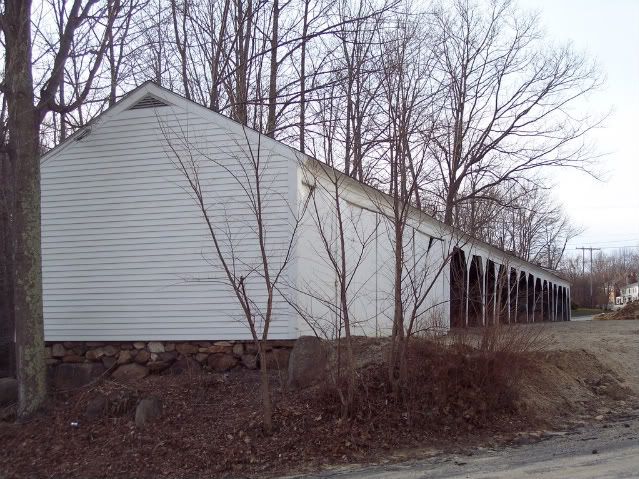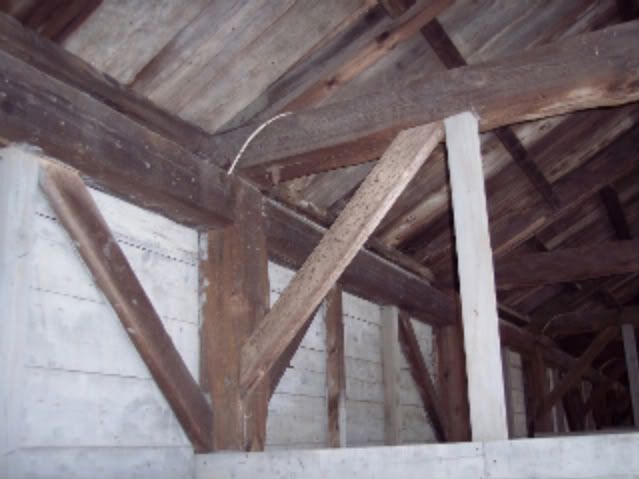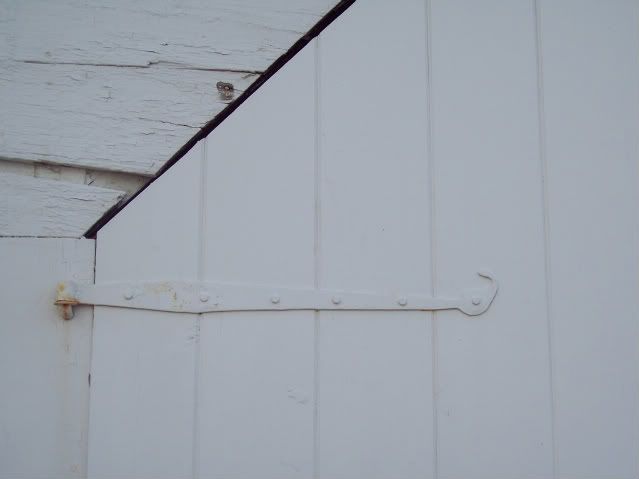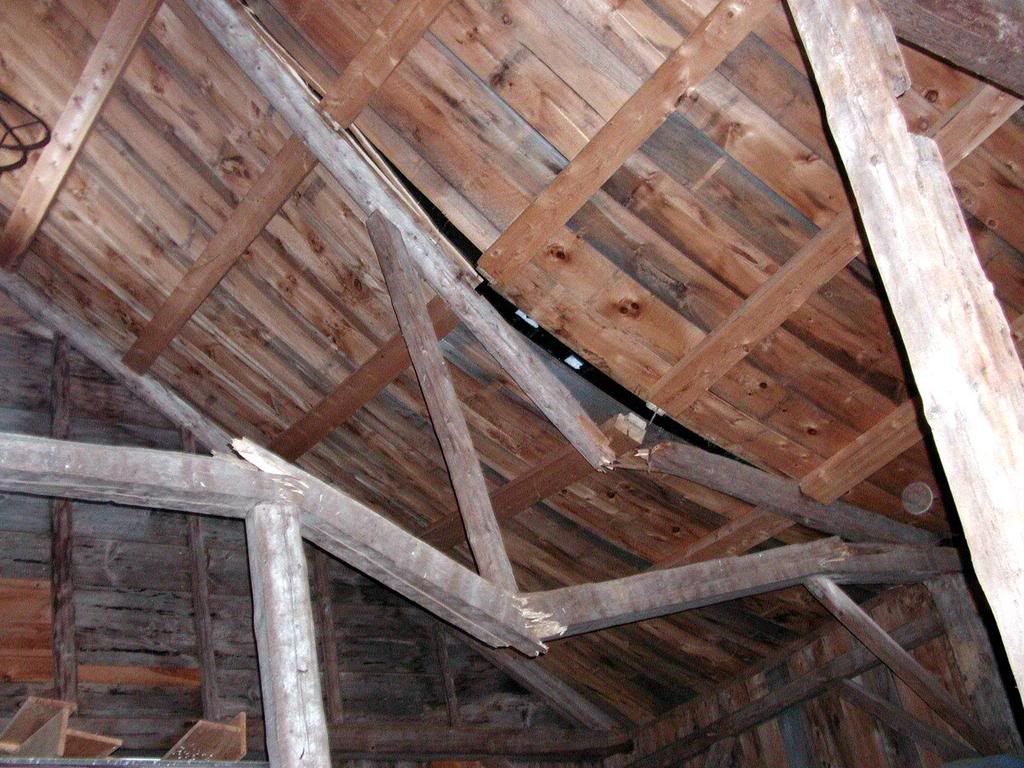|
 Re: Pegs -- riven, sawn, drawn, turned, driven, etc?
[Re: Housewright]
#16131
07/07/08 08:02 PM Re: Pegs -- riven, sawn, drawn, turned, driven, etc?
[Re: Housewright]
#16131
07/07/08 08:02 PM
|
Joined: Aug 2007
Posts: 21
Sussexoak

Member
|

Member
Joined: Aug 2007
Posts: 21 |
The pins I am referring to are for securing a mortice and tenon joint.
As Ken points out, the mortice and tenon is temporarily secured during layout with a hook pin, a metal tapered pin.
But remember also that the tapered framing pins are able to be removed by drifting them out from the inside of the frame.
I use "treenail" for the square pegs fitted into a round hole, used to secure scarf joints together and to secure purlins to rafters etc.
|
|
|
 Re: Pegs -- riven, sawn, drawn, turned, driven, etc?
[Re: Will Truax]
#16132
07/07/08 09:28 PM Re: Pegs -- riven, sawn, drawn, turned, driven, etc?
[Re: Will Truax]
#16132
07/07/08 09:28 PM
|
Joined: Mar 2008
Posts: 570
OurBarns1

Member
|

Member
Joined: Mar 2008
Posts: 570 |
Jim & Don – The trunneled rafter to tie connection is a hyper regional variation unique to coastal Maine & NH – I know of but one inland example, got pix, I’ll upload to p-bucket and post one tomorrow
Will, I do not have a picture, but I saw it w/ my own eyes. The carpenter can attest as well. The barn is in New Gloucester, Maine, about 7 miles from where we'll be meeting this weekend... all hand hewn from the early 1800's... and it's a CG. Interesting that it's regional like you say. This particular barn is about 15 miles inland (according to Google maps). Don
Don Perkins
Member, TFG
to know the trees...
|
|
|
 Re: Pegs -- riven, sawn, drawn, turned, driven, etc?
[Re: OurBarns1]
#16133
07/08/08 10:19 AM Re: Pegs -- riven, sawn, drawn, turned, driven, etc?
[Re: OurBarns1]
#16133
07/08/08 10:19 AM
|
Joined: May 2002
Posts: 447
Will Truax

Member
|

Member
Joined: May 2002
Posts: 447 |
Don’t know the extent of the range, just know what was shared at TTRAG ’04 and that I don’t see it in my neck, which is not all that far inland. I did find it in this Meeting House carriage shed, a little to the south west and farther inland, and an area whose buildings I am very familiar with…  A level cut and a trunnel – So I guess we’re still on topic.  Don’t think the hinges are, but I couldn’t resist. 
|
|
|
 Re: Pegs -- riven, sawn, drawn, turned, driven, et
[Re: Will Truax]
#16137
07/08/08 05:07 PM Re: Pegs -- riven, sawn, drawn, turned, driven, et
[Re: Will Truax]
#16137
07/08/08 05:07 PM
|
Joined: Mar 2008
Posts: 570
OurBarns1

Member
|

Member
Joined: Mar 2008
Posts: 570 |
Will: Interesting that the trunnel protrudes through the crosstie. I'm not 100 percent sure, but in the barn I saw, no evidence can be seen... you have to remove roof boards to see the top of the trunnel: the bottom cannot be seen. The only way we saw it was upon the carnage. Check the photo. The snow got the better of this one.  The barn was built w/ undersized timbers 6x6. And the purlins-- that are spiked to the rafter--and roof deck are replacements from a restoration about 10-15 years ago.
Don Perkins
Member, TFG
to know the trees...
|
|
|
 Re: Pegs -- riven, sawn, drawn, turned, driven, et
[Re: OurBarns1]
#16138
07/08/08 05:09 PM Re: Pegs -- riven, sawn, drawn, turned, driven, et
[Re: OurBarns1]
#16138
07/08/08 05:09 PM
|
Joined: Mar 2008
Posts: 570
OurBarns1

Member
|

Member
Joined: Mar 2008
Posts: 570 |
Don Perkins
Member, TFG
to know the trees...
|
|
|
 Re: Pegs -- riven, sawn, drawn, turned, driven, et
[Re: ]
#16147
07/09/08 11:50 PM Re: Pegs -- riven, sawn, drawn, turned, driven, et
[Re: ]
#16147
07/09/08 11:50 PM
|
Joined: Feb 2006
Posts: 332
Housewright

Member
|

Member
Joined: Feb 2006
Posts: 332 |
Don;
I wrote that I do not recall seeing boards pinned to framing, only planks. I that what you are asking me about?
Jim
The closer you look the more you see.
"Heavy timber framing is not a lost art" Fred Hodgson, 1909
|
|
|
 Re: Pegs -- riven, sawn, drawn, turned, driven, et
[Re: Housewright]
#16149
07/10/08 01:20 AM Re: Pegs -- riven, sawn, drawn, turned, driven, et
[Re: Housewright]
#16149
07/10/08 01:20 AM
|
Joined: Mar 2008
Posts: 570
OurBarns1

Member
|

Member
Joined: Mar 2008
Posts: 570 |
Jim
I guess I was wondering about pin/peg use outside of timber-to-timber joinery. Sounds like you have seen planks pinned (to joists, right?) Were the pins/pegs like normal timber-to-timber ones or different? Were they inserted at an angle, etc?
My curiosity stems from the whole "treenail" concept. Because nails were rare/costly, I think treenails could have been used to fasten sheathing/boards.
I guess this begs the question on the origin of the word "nail." You know, a sort of which came first kind of thing: the peg or the nail? (I know it's the peg, but why refer to them as "nails" at all?)
Treenail is a sort of hybrid word that hints they (pegs/pins) were used as nails.Maybe a look in the old dictionaries about "nail" would be interesting. It's origin and date etc.
KEN,
Are you listening? Have you seen pegs/pins/treenails attaching boards or sheathing?
I'd like to try it sometime...
Don Perkins
Member, TFG
to know the trees...
|
|
|
 Re: Pegs -- riven, sawn, drawn, turned, driven, et
[Re: OurBarns1]
#16150
07/10/08 06:51 AM Re: Pegs -- riven, sawn, drawn, turned, driven, et
[Re: OurBarns1]
#16150
07/10/08 06:51 AM
|
Joined: Mar 2002
Posts: 961
Ken Hume

Member
|

Member
Joined: Mar 2002
Posts: 961 |
Hi Don,
I am struggling to think of examples but one that does come to mind is ship decking where nails would corode quite quickly in service.
Another might be in the construction of clay dabbins, a rude cruck variant found in the Solway Firth area on the border between Scotland and England. These have plank roofs where the planks interlock and are pegged at the ridge running vertically down to sit on top of the side purlin and / or wall plate and where lower "half" planks are fitted then this is done by driving a treenail through one end of the plank which is then simply hung over the purlin and draped over the wall plate at the lower end. No pegs are applied at the lower ends of the plank rafters. The whole roof is then covered with turfs. Check out "Clay Dabbins - Vernacular Buildings of the Solway Plain" by Nina Jennings (ISBN 1-873124-38-4). My son gave Will Beemer a copy of this book so anyone visiting Heartwood School can check this out in their library.
I will forward the question about nails to Chris How MSc. (timber building expert) in Australia who is currently preparing a thesis on nails with professor Miles Lewis at Melbourne University.
The problem with using treenails with thin members would most likely relate to splitting of the thin member especially when driven near the ends which makes the clay dabbins example all the more intersting.
Is "clay dabbins" in the glossary.
Regards
Ken Hume
Looking back to see the way ahead !
|
|
|
 Re: Pegs -- riven, sawn, drawn, turned, driven, et
[Re: Ken Hume]
#16151
07/10/08 10:21 AM Re: Pegs -- riven, sawn, drawn, turned, driven, et
[Re: Ken Hume]
#16151
07/10/08 10:21 AM
|
Joined: Dec 2007
Posts: 1,882
TIMBEAL

Member
|

Member
Joined: Dec 2007
Posts: 1,882 |
I think it is in one of Sobons books where there is mention of pegs at the eve to support a gutter. The gutter just sat on the peg, not through it. They found evidence of peg holes along the top plate which suggested a gutter? The original gutter system of course was long gone. Tim
|
|
|
 Re: Pegs -- riven, sawn, drawn, turned, driven, et
[Re: TIMBEAL]
#16153
07/10/08 02:08 PM Re: Pegs -- riven, sawn, drawn, turned, driven, et
[Re: TIMBEAL]
#16153
07/10/08 02:08 PM
|
Joined: Mar 2002
Posts: 961
Ken Hume

Member
|

Member
Joined: Mar 2002
Posts: 961 |
Hi Don,
I have received the following email reply from Chris How in Australia and an extract from the same follows :-
Try CF Innocent pp176/177 for slate pegs. You may find the Romans used pegs to affix slates of stone or tile. Why the term trenail is used I guess is that the “peg” then fulfills another function, which is actually to effect a joint, against the peg, which is only to hang the slate or tile. The first settlement at Sydney in Australia used pegs thro cleft shingles, but these expanded when wet and cracked the wooden shingles, so there was an appeal to the motherland for shingling nails.
Nails go back to at least 3000BC so there is little point in asking why the word originated. We take “nail” from the Germanic/Norse root NAEGEL, whereas the French take “clous” from the Latin root, CLEVUS. The modern German word for trenail is DUEBEL, pronounced Derbelle, or T’derbelle. With some stretch of the imagination one could suppose that there is a phonetic shift from the Anglo-Saxon which would corrupt towards “trenail” given 1200 years or so. The Germans do not have a distinction between a peg and a trenail, so far as I am aware.
I read recently somewhere that the decorative head on spikes derives from their origins in timber which were left projecting and chamfered off or sculped out for appearance sake. These show in some German illustrations, but I know of no English equivalent. It may also be in Innocent.
There is a heritage woolshed in South Australia which has a red gum floorboards onto joists of red gum, all pegged together. Very unusual, even for Australia. So far as I know these are vertical holes and not angled. The driving–in process gives the tight fit required. There must be Medieval equivalents in UK of same.
There is a theory that nails derived from thorns used as pegs in the middle east, but the earliest illustration I have seen was a bronze age cast bronze nail. Fiona Keith Lucas may know what the ancient Egyptians used.
Most ship-board terms are straight Anglo-Saxon and convert across to specialized forms in mining/civil engineering terms such as “head-tree”. Can’t think of anymore at present.
C How
Looking back to see the way ahead !
|
|
|
|
|